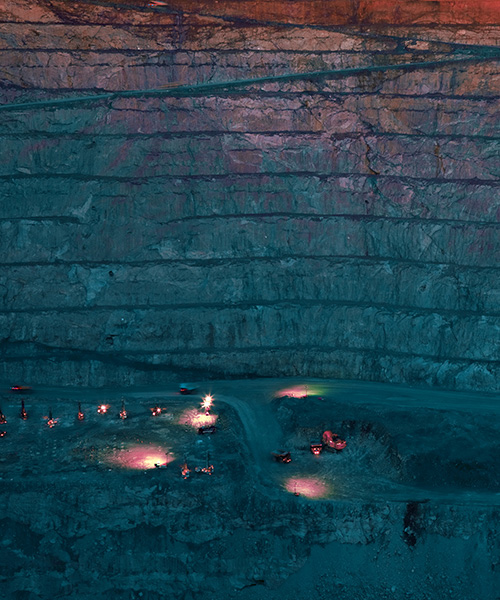May 17, 2022 • 5 min read
Can in-pit crushing and conveying make mining more sustainable?
How a 70-year-old mining technology is decarbonizing modern mine sites
“The mining industry depends on diesel today,” says Nicholas Russell, Principal Mechanical Engineer at Worley. “Diesel is an easily storable fuel that powers most of the machines that extract and move ore.
“However, the existential challenge for mining companies is that every liter of diesel consumed by trucks, diggers, bulldozers, and generators adds more CO2 into the atmosphere,” continues Russell. “This doesn’t align with the mining industry’s commitment to decarbonization, so any technology that can reduce fossil fuel consumption is back on the agenda.”
This challenge has led to the re-emergence of an old technology that can move high volumes of material with a fraction of the CO2 emissions.
In-pit crushing and conveying: a flexible solution for sustainable mining
Today, most mines depend on large mining trucks to haul material out of the mining pit to crushing and processing plants.
“In-pit crushing and conveying (IPCC) is a direct alternative to this approach,” explains Russell. “It involves crushing ore and waste material in an open pit, and then using long conveyors – rather than trucks – to transport the material out of the mine to the processing plant and waste dumps.”
While IPCC is not new, it’s often associated with rigid and inflexible mine plans, which struggle to meet changing market demands.
“That’s how IPCC systems used to be,” says Russell. “The difference today is it’s no longer just a fixed asset. IPCC systems can provide greater flexibility and sustainability thanks to design innovation, tailored equipment, and automation.”
Reducing haulage energy with a truckless system
Modern IPCC systems are more capable and flexible than before. And these new solutions can revolutionize how miners move raw material.
“One of the new ways to implement IPCC is by using a combination of relocatable and mobile conveyors in tandem with a mobile, truckless system,” explains Russell. “Here, a shovel dumps material into a moveable sizing rig that loads the automated conveyor fleet.
“Much like irrigation sprinkler machines, the system operates in parallel, or pivot, and a combination of different length hoses and pipes connect it back to the process plant,” Russell continues. “By increasing the reach of the system, miners can consider multiple combinations of bench level, mine direction and pass widths. This is critical because no two mines – or stages of a single mining project – are the same.
“This flexibility allows IPCC systems to drive large reductions in diesel consumption,” says Russell. “In one study, an IPCC system replaced an overburden truck fleet that moved material from the mine face to the top of the in-pit dump. This reduced haulage energy by 63 percent. And if the system is powered by renewables, it could replace 3.5 Olympic swimming pools of diesel per year for each shovel swapped over.”

IPCC system at Vale's S11D mine
Providing flexibility for minimum viable projects
As the mine face moves, a relocatable IPCC system can move with it.
“In this case, battery trucks powered by renewable electricity can complete short distances to a crusher, which is moved periodically, with conveyors used for the rest of the journey to the processing plant,” describes Russell. “While both options offer flexibility to change mining locations, this option provides the energy efficiency and cost effectiveness of conveyors while benefiting from the flexibility of a truck system.”
This flexibility is especially useful for miners establishing sites with minimum viable capital.
“Miners can start with a small truck fleet and minimum fixed plant, and then relocate the crusher and conveyor as and when required,” says Russell. “This is a key advantage, because it helps achieve project specific goals through different mine sequences. And overall, can make a mine more environmentally sustainable.”
Enhancing an IPCC system with bulk ore sorting technology
As miners seek to extract more material with less energy, IPCC can be even more effective when combined with an ore sorting, mineral sensing technology such as NextOre.
“NextOre technology allows miners to sort and evaluate ore from the mine face,” says Russell. “It maximizes recovery by determining the different grades of ore on a conveyer and establishing whether to accept or reject it at the processing plant.”
NextOre is well-suited to IPCC conveyors, whether retrofitted or implemented from new.
“This technology increases the grade of ore while maintaining throughput on existing systems,” he explains. “It maximizes metal recovery through the entire system, assuming upstream and downstream facilities can be de-bottlenecked.
“Improving sorting efficiency, and processing a better material grade, can reduce water and electricity consumption per tonne of ore mined,” continues Russell. “This is because the real-time data helps miners to pinpoint and extract the highest-grade ore that consumes the least energy to process.”
Providing flexibility of energy source
IPCC can be a very energy efficient option for miners, especially when powered by electricity from the grid or a distributed energy system.
“Because an IPCC system can run on electricity, it gives miners the flexibility to choose renewables to power their site, while moving the same volume of material from the mine face to the process plant and waste dump as they would with trucks and diggers,” notes Russell.
“This increases the incentive for miners to transition to lower carbon sources of electricity. And it could also present an opportunity to reduce energy costs over time.”
IPCC in action
One of the world’s largest iron ore mines in Brazil is demonstrating how new IPCC technology is enhancing sustainability, as well as protecting people and the environment.
“For this project, we proposed a truckless mine, which was the first of its kind,” explains Russell. “The system uses mobile crushers and conveyors to replace trucks, reducing diesel consumption by approximately 70 percent. The system also allows our customer to process waste in existing industrial areas, moving it away from environmentally sensitive areas to further reduce the project’s environmental impact.
“In designing this project, our team’s biggest challenge was not only rethinking the mine plan and how to use the technology on site, but also re-evaluating the role people play in the mining process,” he says. “Transitioning to IPCC also represents an opportunity to upskill technicians and engineers, who can then use these technologies safely and efficiently,” continues Russell. “It also helps to take people out of harm’s way, by reducing the need for haul truck drivers.”
Tailoring mining technologies to have the greatest sustainability impacts
IPCC has a growing role to play in the future of mining. However, sustainable mining is complex, and no individual technology can solve the sustainability challenge alone.
“To focus solely on the benefits of the equipment and disregard the mine demands is a short term solution to a long term challenge,” says Russell.
“Miners need flexibility, collaboration, and a holistic approach to implementing new technologies that starts at the mine plan. If we get this right, IPCC can be part of the solution to a truly environmentally sustainable mine.”
All images courtesy of Vale.


